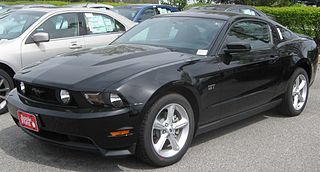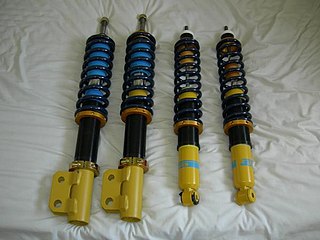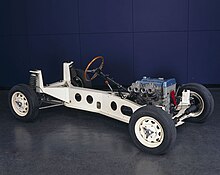
The MacPherson strut is a type of automotive suspension system that uses the top of a telescopic damper as the upper steering pivot. It is widely used in the front suspension of modern vehicles, and is named for American automotive engineer Earle S. MacPherson, who invented and developed the design.

A strut is a structural component commonly found in engineering, aeronautics, architecture and anatomy. Struts generally work by resisting longitudinal compression, but they may also serve in tension.

The Lotus Europa name is used on two distinct mid-engine GT cars built by British automobile manufacturer Lotus Cars. The original Europa and its variants comprise the Lotus Types 46, 47, 54, 65 and 74, and were produced between 1966 and 1975.

Suspension is the system of tires, tire air, springs, shock absorbers and linkages that connects a vehicle to its wheels and allows relative motion between the two. Suspension systems must support both road holding/handling and ride quality, which are at odds with each other. The tuning of suspensions involves finding the right compromise. It is important for the suspension to keep the road wheel in contact with the road surface as much as possible, because all the road or ground forces acting on the vehicle do so through the contact patches of the tires. The suspension also protects the vehicle itself and any cargo or luggage from damage and wear. The design of front and rear suspension of a car may be different.

Independent suspension is any automobile suspension system that allows each wheel on the same axle to move vertically independently of the others. This is contrasted with a beam axle or deDion axle system in which the wheels are linked – movement on one side does not affect the wheel on the other side. "Independent" refers to the motion or path of movement of the wheels or suspension. It is common for the left and right sides of the suspension to be connected with anti-roll bars or other such mechanisms. The anti-roll bar ties the left and right suspension spring rates together but does not tie their motion together.

The Ford D2C platform is one of Ford's rear-wheel drive automobile platforms.

A double wishbone suspension is an independent suspension design for automobiles using two wishbone-shaped arms to locate the wheel. Each wishbone or arm has two mounting points to the chassis and one joint at the knuckle. The shock absorber and coil spring mount to the wishbones to control vertical movement. Double wishbone designs allow the engineer to carefully control the motion of the wheel throughout suspension travel, controlling such parameters as camber angle, caster angle, toe pattern, roll center height, scrub radius, scuff and more.

A coilover is an automobile suspension device. The name coilover is an abbreviation of "coil-over shock absorber".

A de Dion tube is a sophisticated form of non-independent automobile suspension. It is a considerable improvement over the swing axle, Hotchkiss drive, or live axle. Because it plays no part in transmitting power to the drive wheels, it is sometimes called a "dead axle".

An anti-roll bar is a part of many automobile suspensions that helps reduce the body roll of a vehicle during fast cornering or over road irregularities. It connects opposite (left/right) wheels together through short lever arms linked by a torsion spring. A sway bar increases the suspension's roll stiffness—its resistance to roll in turns—independent of its spring rate in the vertical direction. The first stabilizer bar patent was awarded to Canadian inventor Stephen Coleman of Fredericton, New Brunswick on April 22, 1919.

The Lotus 17 was a sports car racing model built by Lotus Cars in 1959. Designed by Len Terry, it was built in response to the Lola Mk1 which was dominant against the previous Lotus model, the Eleven. It was replaced in 1960 by the Lotus 19.

In automotive suspension, a control arm, also known as an A-arm, is a hinged suspension link between the chassis and the suspension upright or hub that carries the wheel.
Torque steer is the unintended influence of engine torque on the steering, especially in front-wheel-drive vehicles. For example, during heavy acceleration, the steering may pull to one side, which may be disturbing to the driver. The effect is manifested either as a tugging sensation in the steering wheel, or a veering of the vehicle from the intended path. Torque steer is directly related to differences in the forces in the contact patches of the left and right drive wheels. The effect becomes more evident when high torques are applied to the drive wheels because of a high overall reduction ratio between the engine and wheels, high engine torque, or some combination of the two. Torque steer is distinct from steering kickback.

The Lotus 18 was a race car designed by Colin Chapman for use by Lotus in Formula Junior, Formula Two, and Formula One.

The Lotus 23 was designed by Colin Chapman as a small-displacement sports racing car. Nominally a two-seater, it was purpose-built for FIA Group 4 racing in 1962–1963. Unlike its predecessors Lotus 15 and 17, the engine was mounted amidship behind the driver in the similar configuration developed on Lotus 19.

The Lotus 12 was a Formula Two and Formula One racing car.
The Fiat C-platform was an automobile platform used in small family cars of the Fiat Group. The predecessors of the C-platform were the Type Three and Type Two platforms, and the successor is the new Compact platform which debuted in Alfa Romeo Giulietta in 2010.

Haynes Roadster is a replica of Lotus Seven home-built according to a book Build Your Own Sports Car: On a Budget by Chris Gibbs (ISBN 1-84425-391-0). Ford Sierra is used in the car as a donor for drivetrain and suspension components.
The 'Queerbox' was the nickname for an early sequential manual transaxle used by Lotus racing cars of the late-1950s and early-1960s, and was very similar in design and operation to a motorcycle gearbox. It was infamously unreliable.

A platform chassis is a form of vehicle frame / automobile chassis, constructed as a flat plate or platform, sometimes integrating a backbone or frame-structure with a vehicle's floor-pan.




















